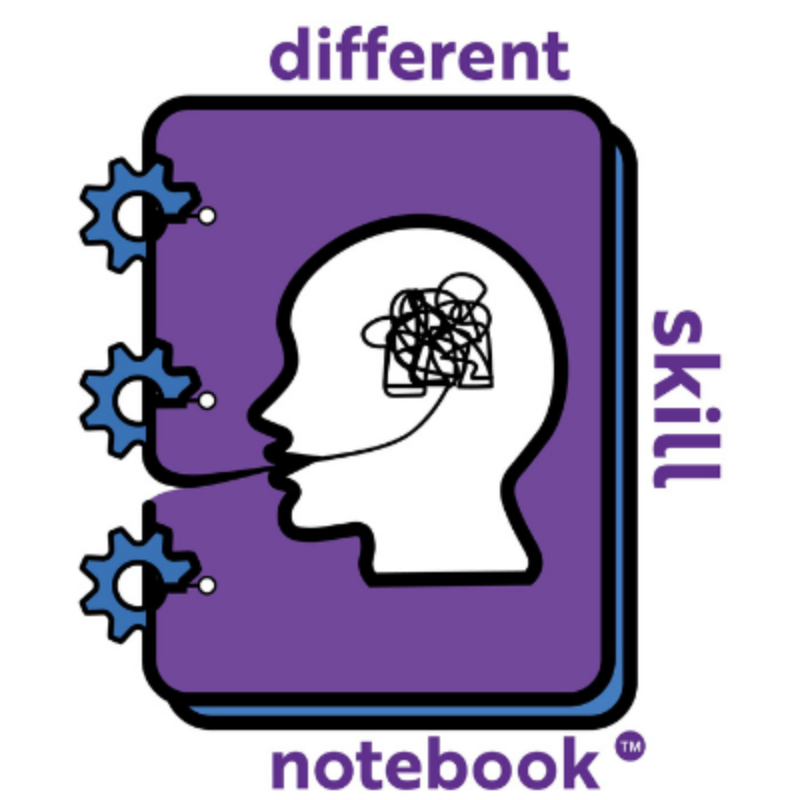
1.7K
Downloads
33
Episodes
The Social Mind Center presents the ”different skill notebook” a tool that provides strategies to build social-emotional skills resulting in social competency. Since March our world has experienced many changes with the COVID pandemic. Change is the new constant in our daily lives. Requiring us to be adaptable and adjust to the changes daily. The different skill notebook is a life curriculum for you to equip your child with the skills to communicate, connect, and build relationships for life. We want our children to have success beyond academics by acquiring skills to adapt, cope, self-manage and find purpose in life.
Episodes

Tuesday Jun 21, 2022
What is the most important social skill?
Tuesday Jun 21, 2022
Tuesday Jun 21, 2022
WHAT IS THE MOST IMPORTANT SOCIAL SKILL?

When I think about our work at the Center teaching social competency, there are many layers to teaching these skills. For those who have social communication skills come easy. We never give much thought to what it feels like for those who struggle with social, emotional, communication, and self-management skills.
If I were to pick one most important skill in developing social competency, that would be turn-taking. All socialization and communication is a back and forth. Children with social competency difficulties can struggle with this with fundamental skills. There is no social interaction that does not require turn-taking.
Social-emotional reciprocity is the back and forth interaction that takes place in communication. (Norris, 2018)
We take a social approach to have conversations with others, and we share our interests in our discussions. Part of that social-emotional reciprocity is knowing how and when to initiate or respond to others' social interactions (Norris, 2018).
Some of the skills necessary to engage in social-emotional reciprocity include:
-
Waiting for a turn to speak in school or meeting
-
Talking to someone
-
Making eye contact
-
Demonstrating something
-
Writing a note, email, etc.
These are all examples of back and forth in communication and social situations. Turn-taking and waiting are fundamental skills to navigate every day in our communities. Turn-taking should be incorporated into all teaching as it is essential to social competency (Norris, 2018).

Skill: Turn-taking
In the Anselma home, we focused on turn-taking daily. In prioritizing helping Nick develop communication, we sat and played every day. The play was part of so many aspects of our home life as turning-taking is part of all play. The underlying foundational turn-taking skills are cognitive flexibility (transitioning -shifting mindsets), thinking of others (perspective), and impulse control.
Start by playing what they love to play or doing what they love to do.
Strategy:
Turn-taking takes much practice for all kids. There is no clarity as to when it will be their turn. I prefer to take a favor, and/or my turn then your turn. Often the word sharing is used; however, for kids with weaknesses in social communication, sharing can be a more abstract concept. It's a bit more precise.
A foundational component of communication and socializing is taking a turn. It is not a conversation or playing if there is no turn-taking/back and forth.

Build:
Consistently and repeatedly model turn-taking and thinking of others. There is a why to turn-taking: we need to think of others. It is perspective-taking thinking of others' thoughts and emotions. The family unit is the first social group your child will encounter.
-
When my kids were young and during our teen years which we are still in, I would say "your turn" to pick the restaurant, activity, or game.
-
When my kids were toddlers and early elementary, I would join in whatever they were doing, and then I would ask them can I have a turn now.
-
With homework, I would help them by doing a problem or sampling/modeling the task so they could see it being done.
-
I would say can I help you get started, then I would say now it is your turn; you continue. I would also get things started and let them finish.
-
Our family often traveled, so we would say your turn to pick a place to eat or visit since you accompanied us on our adventure. We would take turns on whose activity would go first in the day.
-
For siblings, one child mustn't control the family. That you take turns with their requests.
When they are young, it needs to be more literal and physical, as if you would pass a ball back and forth. As they become preteens and teens, you need to discuss more the thinking of others. I constantly shared my perspective with my kids and what the other person's perspective may be. It was a three-part exchange:
-
What am I thinking and feeling about this situation?
-
What are you thinking and feeling about this situation?
-
What do you think they are thinking and feeling about it?
It is developmentally appropriate to be self-centered during the teen years, so requiring your kids to take a turn is even more critical. You cannot allow your home to become child-centered. You must help them acknowledge all family members and that they have preferences as well.
Social media does not help with monologues since they can have a one-way conversation all day. I frequently see parents letting young children and teens monopolize the conversation. They never redirect or say, " Let's hear what your friend has to say.

Social turn-taking and sharing space:
When my kids were having difficulty sharing space or engaging with us. I would join them and sit there for a while with them so that they grow accustomed to me in their area.
-
sharing space in close proximity is vital to establish joint attention (paying attention to the same thing)
-
Ask to look at what they are looking at or doing
-
use the language "my turn" and "your turn."
-
give them a turn when doing anything together, even if they don't ask for it
-
Some children or teens have difficulty turn-taking when in situations where the environment is unfamiliar, or many people. In these situations, the child/teen feels that they have less control which may make them feel extremely uncomfortable. In these situations, they will seek to take control, and the response may not always be socially expectable. Their reaction may be to engage their peer group, disrupting play or conversation abruptly. They intend to join in, but the sudden abruptness disregards peers' space and exchange. The best way to help your child/teen ease into these situations is to teach them to observe. Before participating one can be an observer.
-
When entering a social situation, practice with them entering, greeting, waiting, looking, and observing before jumping in.
-
the greeting is important sets the tone, and asking questions, "what are you all up to"
-
practice observing, listening, and imitating before joining situations so that you can model for them
-
provide information on expectations and what are some exit options if they do not feel comfortable or need a break
-
When your child mentions that they are having difficulties with peers, gather information on how they approach and engage peers. Commonly, they may not be waiting their turn and this causes conflicts with peers.
Practice conversational turn-taking with your child as often as you can. Model asking about their day, needs and challenges. Share about your day, needs and challenges. Spend time listening and be a part of their moment or interests especially with teens.
Listening and observing in the teen years is important because there is so much going on in their environment. They may need help navigating this new season in their life, and they may not know how to ask for the assistance they need. I find they need much coaching on what to say and when to say it. Self-advocacy is very important in the teen years, learning to speak up for yourself and your needs.
Works Cited:
K. Norris, BS, MEd, Autism Basics, July 24, 2018. The excerpt was taken from this course answering the question What is social-emotional reciprocity.
Resource:
This entire excerpt was taken from Norris's Autism Basic's course
Let's examine some foundational skills that underlie these methods of information sharing.:
Joint attention. One of the basic skills involved in social-emotional reciprocity is joint attention. This typically develops in the first year or two of life. Joint attention is actively paying attention to the same object or activity at the same time with another person. We see babies do this all the time. As you're holding a baby, for example, and he hears an airplane in the sky and sees you look up, he'll also look up to see what it is. He may point at the airplane and look back at you, wanting you to look back at that. This tends to be a skill that children with autism are missing. The lack of joint attention may be one of the early signs of autism.
Imitation. Imitation is another basic skill for social-emotional reciprocity. Parents, teachers, and peers are all people that young children will imitate. Imitation is one of the ways that children learn. If children with autism have that break in that social-emotional reciprocity, if they have that break in that ability to imitate others, then their social communication is negatively impacted.
Reciprocal engagement. Once we have joint attention in place and we have imitation in place, then we usually enter into that reciprocal engagement. Again, it's the back and forth that we need to maintain long enough to learn something, enjoy something, and share something with another person. It's paying attention to people versus paying attention to objects. Children with autism have a tendency to focus strongly on objects. Objects are much more predictable than people and much easier for them to understand because of the deficits in their social communication.
Non-verbal communication. Another area that can be affected in social communication is non-verbal communication. This would include facial expressions, as well as tone of voice. Using a single finger to point to an object is a non-verbal gesture that's important for young children to develop. You'll see very young children indicating what they want by pointing to it. They'll look at the object and then they'll look back at their caregiver to say, "Hey, pay attention to this. This is what I want. I'm pointing right at it." This often happens even before they can tell you the name of the object. Eye contact is a significant part of non-verbal communication and is often something that children with autism will try to avoid. Maintaining eye contact with someone is very uncomfortable for them, mainly because of that gap in their social and communicative abilities. We need to teach them ways that they can use their gestures or behaviors so that they can communicate their wants, their needs, and their interests.
This Ask the Expert is an edited excerpt from a course entitled, Autism Basics.
Kimberly Norris, BS, MEd
Kimberly Norris has been an educator for more than 25 years. She received a master's degree in elementary education with an emphasis in reading from Southeast Missouri State University. She has provided training for early childhood educators on topics ranging from developmentally appropriate practice to adaptations for children with special needs. Presenting both at state and national conferences, she is passionate about educating professionals in the field of early childhood education.

No comments yet. Be the first to say something!